Traveling with perfume can be tricky—bottles may leak, scents can fade, and carrying full sizes takes up space. Knowing simple travel perfume hacks helps keep fragrance fresh, prevents spills, and makes packing easier. These practical tips suit anyone who wants to stay smelling good on the go without hassle.
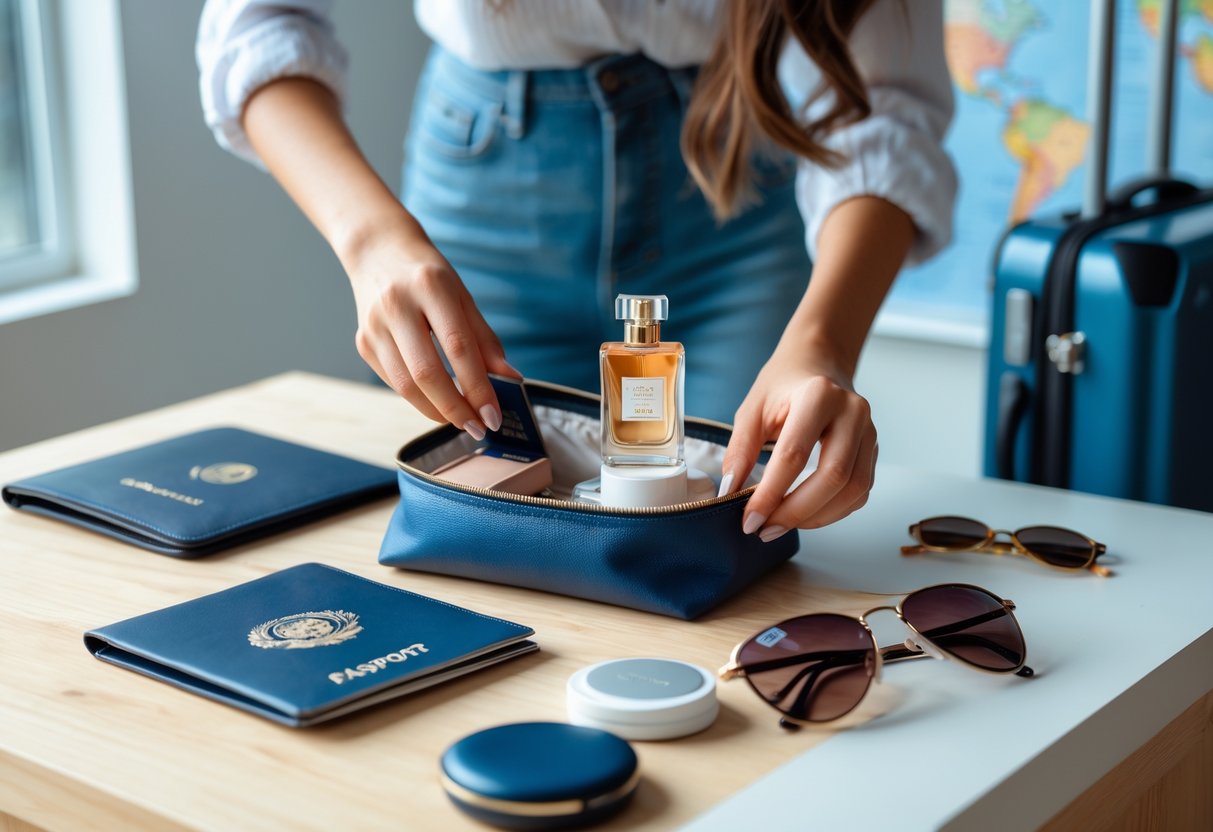
Many find that storing perfume properly, using travel-sized containers, or even repurposing items for scent application increases convenience. Small adjustments can significantly improve how long a fragrance lasts during travel and avoid common problems like broken bottles or lost scents.
Essential Perfume Application Techniques
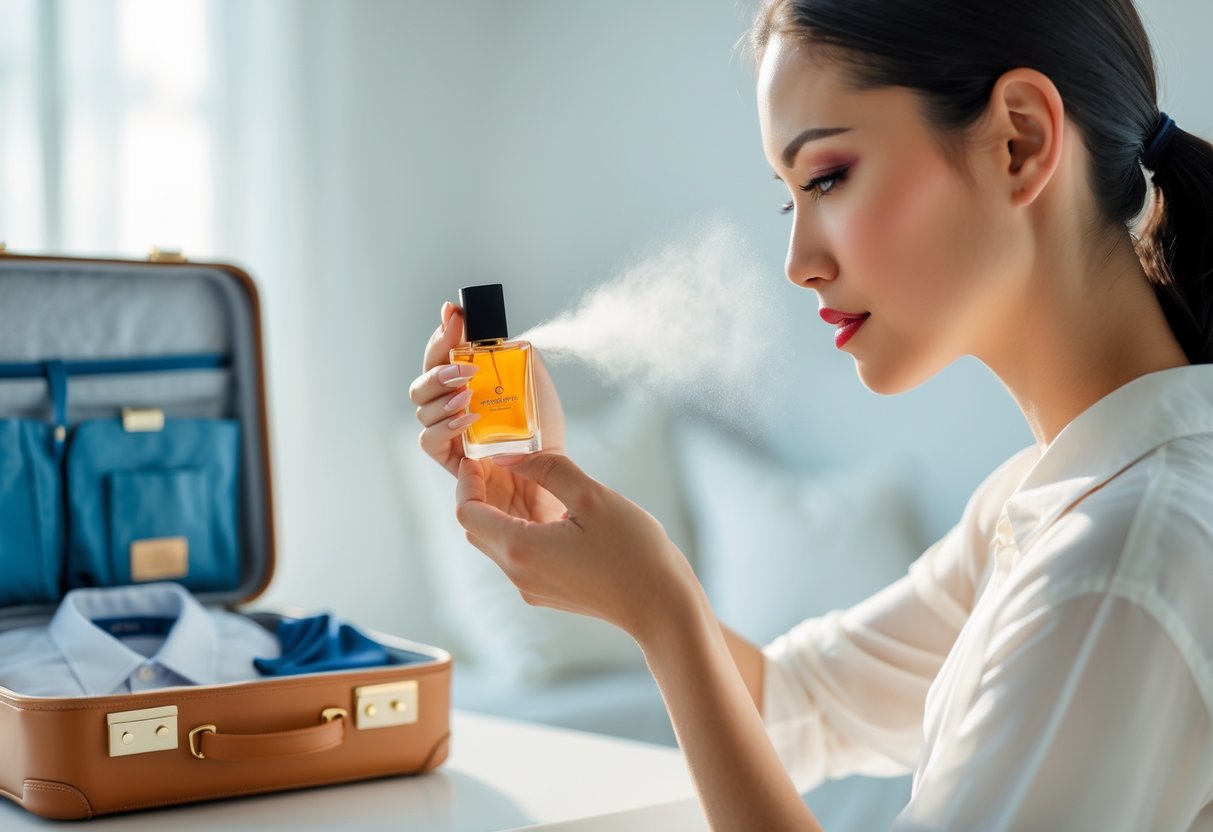
Applying perfume effectively involves understanding where and how to wear fragrance on the body to enhance its scent and duration. Knowing specific pulse points and methods can help achieve a balanced and long-lasting aroma throughout the day.
Maximizing Perfume Longevity
To extend the life of a fragrance, it is important to focus on skin hydration first. Applying an unscented moisturizer or petroleum jelly to pulse points before perfume can help lock in the scent by providing a moist surface for the oils to cling to.
Avoid rubbing wrists together after applying perfume, as this breaks down the fragrance molecules and shortens the scent’s lifespan. Instead, allow the perfume to dry naturally on skin.
Storing perfume away from heat and sunlight preserves its quality, which indirectly affects how long it lasts when worn. Wearing a fragrance in layers, such as body lotion followed by perfume, also improves longevity.
Choosing the Right Pulse Points
Pulse points are areas where blood vessels are close to the skin, emitting heat that helps diffuse the perfume scent. Key pulse points include the wrists, neck, behind the ears, and inside elbows.
Applying fragrance to these spots increases the intensity and projection of the perfume. The warmth from these areas activates the fragrance oils.
Each person’s skin chemistry affects how a scent develops and lingers on these points. Testing perfume on different pulse points can help find the most effective placement for the desired fragrance experience.
How to Apply Perfume for Optimal Scent
Spray perfume from a distance of 5 to 7 inches to allow an even, light mist. This prevents oversaturation and promotes a natural scent trail.
Focus on applying perfume directly to pulse points without rubbing. Dab or let it air dry to preserve the fragrance layers.
For travel or touch-ups, use solid perfume or travel-sized atomizers, which control the amount applied. A small, controlled application ensures the fragrance remains fresh without overpowering.
Smart Packing and Travel Storage Hacks
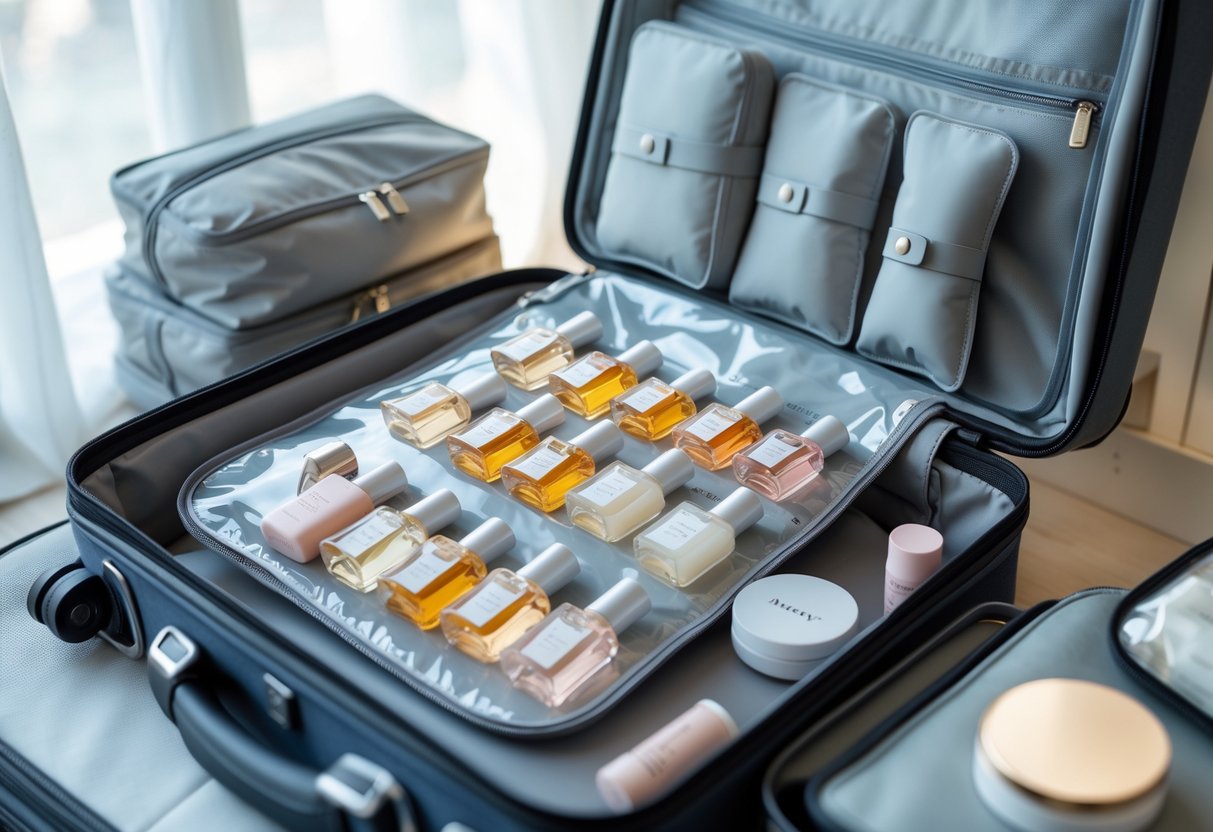
Choosing the right containers and taking steps to prevent spills are essential for carrying perfumes safely during travel. Efficient packing helps preserve fragrance quality and keeps luggage organized.
Best Perfume Travel Containers
Small, durable containers designed specifically for perfume are the most practical choice. Refillable atomizers with tight seals allow travelers to transfer favorite scents from original bottles, saving space and complying with airline liquid restrictions.
Glass travel bottles are common but heavier and prone to breakage. Lightweight plastic or silicone containers are safer alternatives, especially for longer trips. Contact lens cases can also serve as compact, leak-proof storage for solid perfumes or small fragrance samples.
Brands like those found at Sephora often offer travel sets with mini versions of popular perfumes, which fit well in purses or carry-ons. Choosing containers with spray nozzles mimics the ease of the original bottle and maintains scent distribution.
Preventing Perfume Leaks and Breakage
Securing perfume bottles during transit is crucial to avoid leaks or spills. Wrapping bottles in soft materials like cotton pads or bubble wrap provides cushioning against bumps.
Sealing caps tightly and adding a piece of plastic wrap between the spray nozzle and the cap can create an extra barrier against leakage. Placing perfumes upright in a separate, zippered pouch lessens the chance of damage to other items.
Travelers often use hard cases designed for toiletries to protect fragile glass bottles. Perfume from France or other origins should always be stored away from direct sunlight and extreme temperatures, as heat can alter scent composition or damage the bottle.
Taking these steps minimizes mess and preserves the perfume’s integrity throughout the trip.
Boosting and Layering Fragrance on the Go
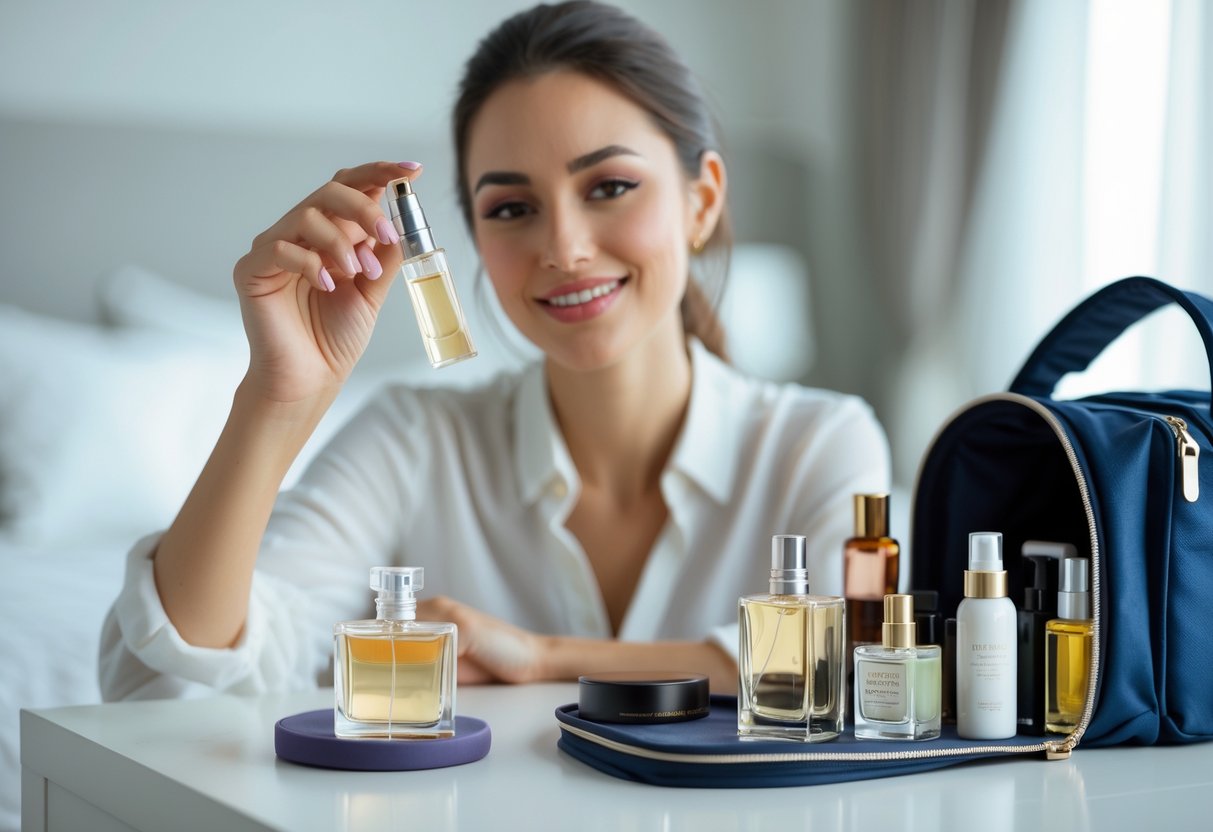
Carrying a fresh scent throughout travel requires simple but effective techniques. Combining and sustaining layers of fragrance with moisturizers and quick fixes like hair mists can prevent a natural scent from fading in different environments.
Fragrance Layering for Longer Scent
Fragrance layering involves applying multiple scented products to create a richer, longer-lasting aroma. Travelers should start with a lightly scented base, such as a lotion or body oil, compatible with their perfume. This foundational layer enhances the overall scent and helps it adhere to the skin.
Applying perfume in light, even spritzes on pulse points like wrists, neck, and behind ears builds intensity without overwhelming. Avoid heavy spraying; instead, layer scents gradually. Combining complementary notes, such as vanilla with musk or citrus with floral, can amplify depth and longevity.
Making Scents Last with Lotions and Balms
Using scented or unscented lotion before perfume is key to extending fragrance life. Hydrated skin retains scent much better than dry skin. Travelers often use hand creams or travel-sized lotions infused with light, neutral scents to prepare their skin.
For an extra moisture boost, a thin layer of petroleum jelly or Vaseline can be applied on pulse points before misting perfume. The jelly traps the scent oils, preventing quick evaporation. This simple step can significantly slow scent loss during long travel days or climate changes.
Quick Fixes: Hair Mist and Scented Accessories
Hair mist offers an efficient way to refresh scent without affecting skin. Since hair holds fragrance longer due to its texture, light application on strands provides continuous scent release as hair moves.
In addition, scented accessories like fragrance-infused scarves or jewelry can subtly boost aroma. These items serve as scent reservoirs but require regular reinvigoration by respraying perfume. They are practical when skin application is limited or inconvenient.
Selecting Travel-Ready Scents and Fragrance Notes
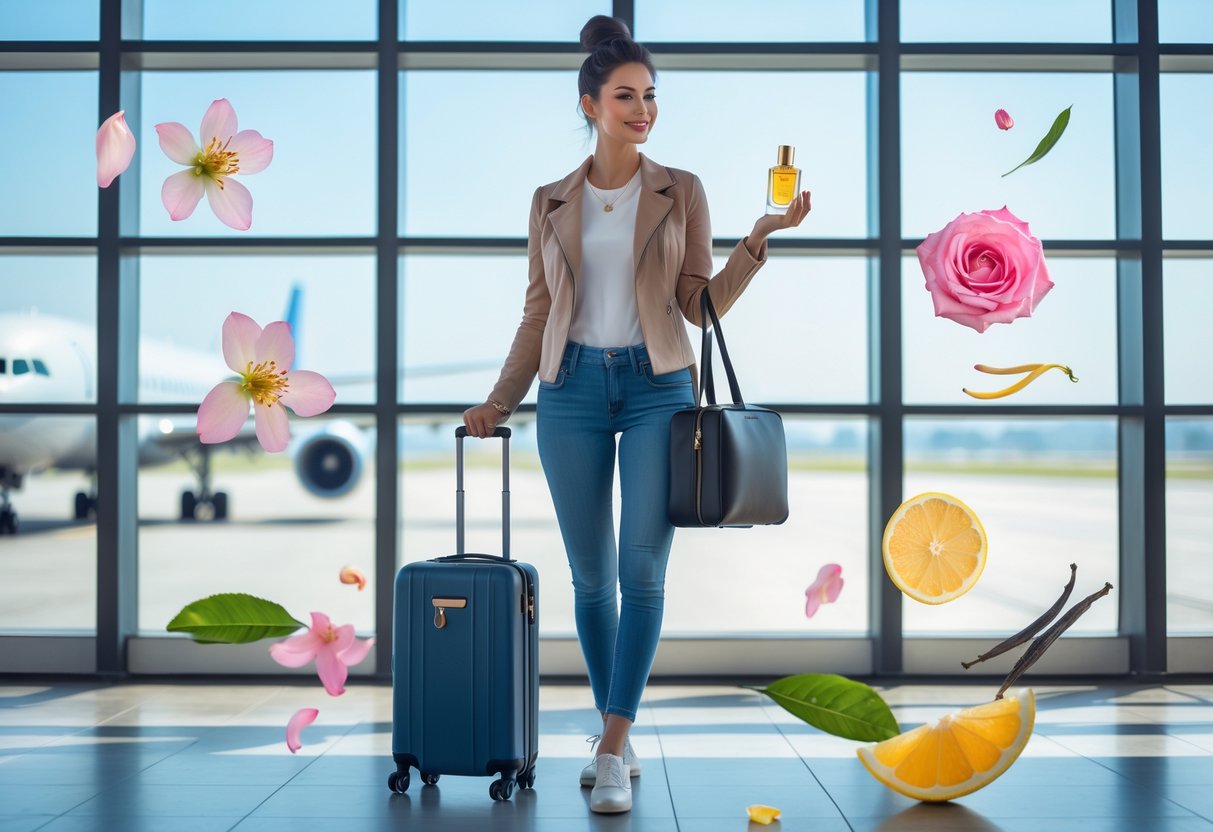
Choosing the right perfume for travel involves considering scent longevity, seasonality, and how easily a fragrance adapts to different settings. Lighter, fresh notes often work better for day trips, while richer, warmer scents suit evening occasions. Understanding the structure of perfumes—top, middle, and base notes—helps in picking scents that remain pleasant throughout varied activities.
Popular Perfume Notes for Travel
Travel-friendly scents usually emphasize fresh and versatile notes because they comfort and energize without overwhelming. Citrus notes such as bergamot, lime, and grapefruit provide an immediate burst of freshness, ideal for daytime wear.
Floral middle notes like jasmine, rose, and ylang-ylang add softness and sophistication, balancing the initial brightness. For longer-lasting impact, base notes such as sandalwood, cedarwood, and vanilla offer warmth and depth that help the fragrance linger.
Focusing on a balanced mix of these notes ensures the perfume transitions well through changes in temperature and activity while packing compactly.
Signature Scent vs. Versatility
While a signature scent offers personal identity and comfort, travelers benefit from more versatile perfumes. A signature perfume may be too intense or unsuitable for different climates or occasions encountered during travel.
An adaptable fragrance blends light top notes with subtle base notes that don’t overpower confined spaces like airplanes or hotel rooms. For example, mixing elements such as lavender with soft sandalwood can create a scent that works both day and night.
Choosing one perfume that covers multiple settings reduces the need to carry several bottles, saving space and weight.
Natural vs. Synthetic Scents
Natural ingredients like essential oils from rose, lavender, and cedarwood often provide delicate aromas but sometimes lack lasting power in portable forms. Synthetic scents can mimic these natural notes with improved stability and longer wear, which is practical for travel.
Some travelers prefer natural fragrances for their closeness to nature and fewer irritants. However, synthetics allow increased flexibility in fragrance layering and mixing, especially useful for creating unique combinations while on the go.
Balancing natural and synthetic components can yield perfumes that are both pleasing and durable for travel conditions.
